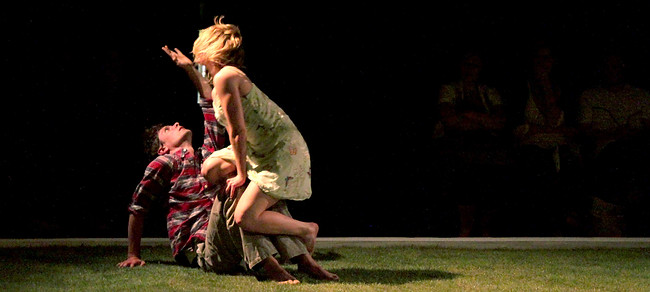
Spectacular performance design by director Sam Trubridge and stunning choreography by Sean MacDonald combine to present a powerful, poignant lament for the lost ecologies and history of Aotearoa NZ. An immersive soundscape by NZ composer Bevan Smith transports the audience through the evolution of the story: a transformation occurs, as Guthrie Smith's principles are interwoven with Māori myth and legend.
Suburban rituals, pastoral tragedies and earthy reveries unfold with happenings "that assault both our senses and our conscience" (Deirdre Tarrant, Capital Times). This evocative production exposes "the ineffectual and damaging attempts by the human race to tame the terrestrial ecosystem" (Jenny Stevenson, Theatreview).
MacDonald will be joined in the performance by dancers Hannah Tasker-Poland, Emmanuel Reynaud, Brydie Colquhoun and Luke Hanna.
Ecology in Fifths is a new production by the makers of Sleep/Wake (Auckland Festival 2009, NZNP Festival New York 2015) and the acclaimed annual Performance Arcade festival on Wellington Waterfront (2011-2019). This new work develops the company’s unique style and explores the integration of musical composition, choreography and set design. This orchestration of performing elements reflects upon the ecologies in our everyday lives, illustrating how microcosmic events can have a significant effect upon global crises.
Reviews
EXPLOITING THE LAND
“In its developmental stage this new exploration by Sam Trubridge and his team of collaborators takes a close-up and 'hyper-visible' look at issues of ecology. It is inspired by the story of the sheep station Tutira (which if my memory serves me is up on the Napier/Gisborne road?) and the documentation of change and preservation that this early analysis of human exploitation and preservation of the natural environment of New Zealand gave us to study.
A square of verdant grass and a green tree pushing its way through in the natural order of things gives way to a range of happenings that assault both our senses and our conscience.
Four dancers bring their individual interpretations and for me the most compelling was the walking phrase that gathered in and spat out each of the four but held them connected to the grass beneath their feet. It spoke of hope and togetherness that was soon shattered.
Surfaces and textures were important. Words that ran through my response to the visceral installation that used black plastic to enclose and tiger turf to layer the land included symmetry and individuality, merging, hinging, collecting, burying, tunnelling, mud, stripping, ripping, staking, claiming, spreading, sharing and collecting.
Vicious at times, disjointed and disquieting, this work asks us to take responsibility and not to walk away… It is all too easy to switch off the reality and this work sat the audience on four sides and gave us no way to avoid it. Generating our own destruction is powerful material and the sound score (Rowan Pierce) and composition (Bevan Smith) carry the work forward as well as sometimes beaching it in a morbid calm.
A challenge is laid down for us to acknowledge and to take or ignore at our peril. Hope glimmers at the end in the form of tiny delicate and fragile stick houses lit by matches and flickering on the desecrated soil.”
GROWTH, DESTRUCTION, IMMOBILITY, STRUGGLE ... AND A GLIMMER OF HOPE?
“In his thoughtful depiction, through dance and installation, of the rape of the land in early colonial New Zealand, Playground director Sam Trubridge hits a raw nerve by exposing the ineffectual and damaging attempts by the human race to tame the terrestrial ecosystem and its more recent efforts to restore balance to the planet.
Using the assault of music “to make the space speak” – as choreographer Carol Brown puts it – Trubridge collaborates with composer Bevan Smith and sonic architect and performer Rowan Pierce to bombard the senses through a variety of soundscapes which create sonic imprints on the graphic images as they unfold.
The dancers not only dance but also manipulate the environment, implementing the various scenic changes and depicting the forces of nature through their bodies. They move imperceptibly between inhabiting the landscape and acting as the instruments of its change.
Trubridge creates a constantly evolving theatrical space in which to enact his rendition of the influential writings of H Guthrie Smith in his book Tutira: the Story of a NZ Sheep Station. In colouration terms, the journey is one that departs from the bright spring green of a lone tree and lush grass and ends with the shiny black of plastic sheeting – all lit with subtle understatement by Marcus McShane…”

